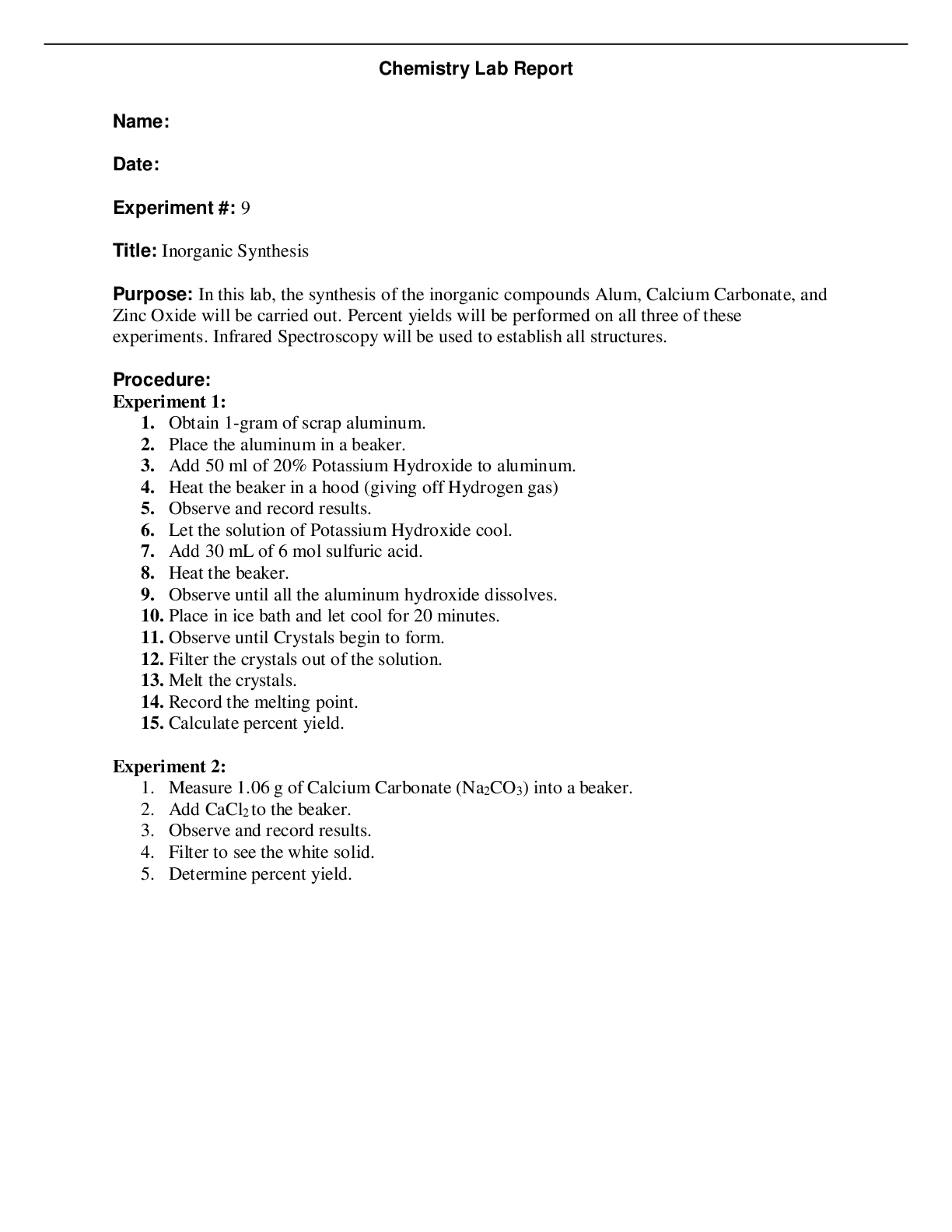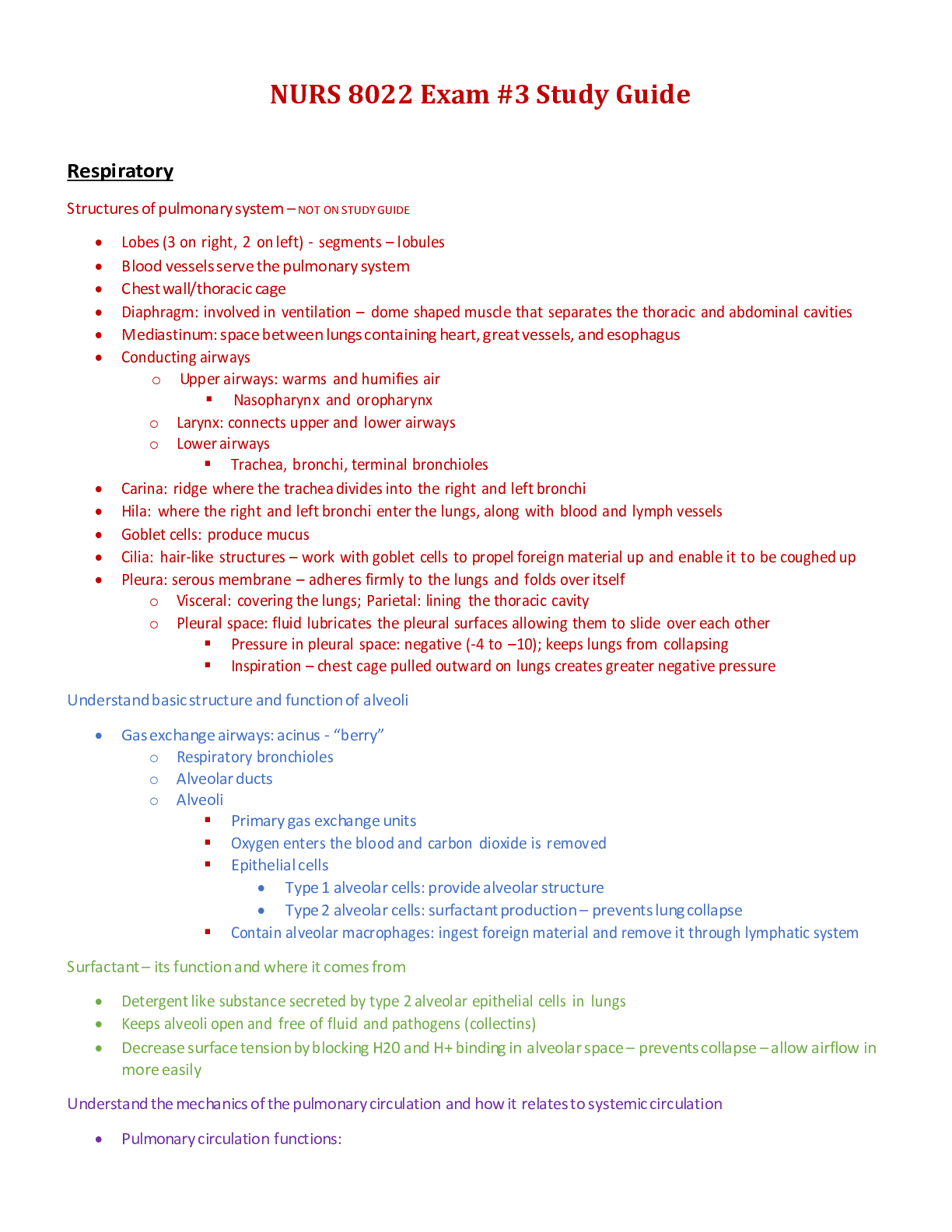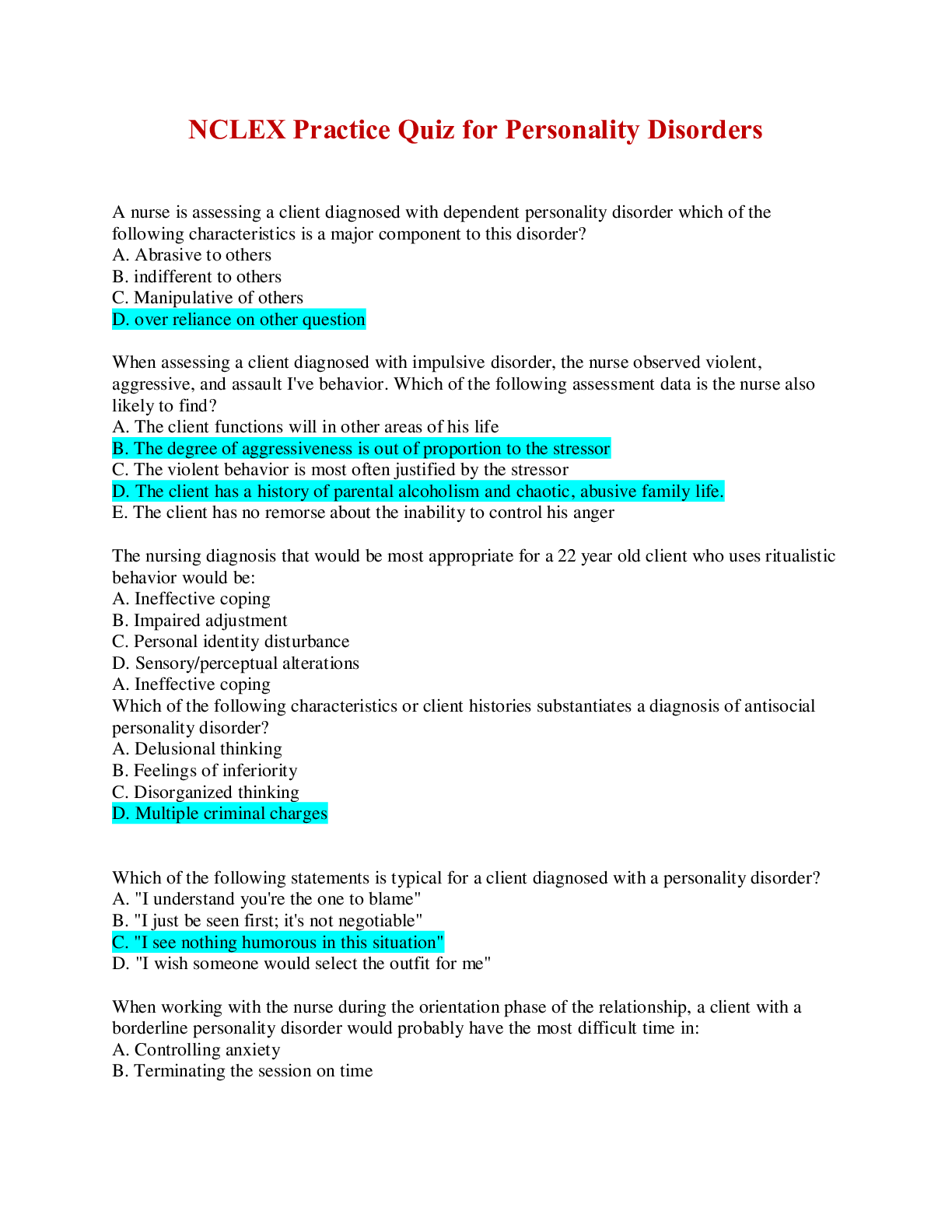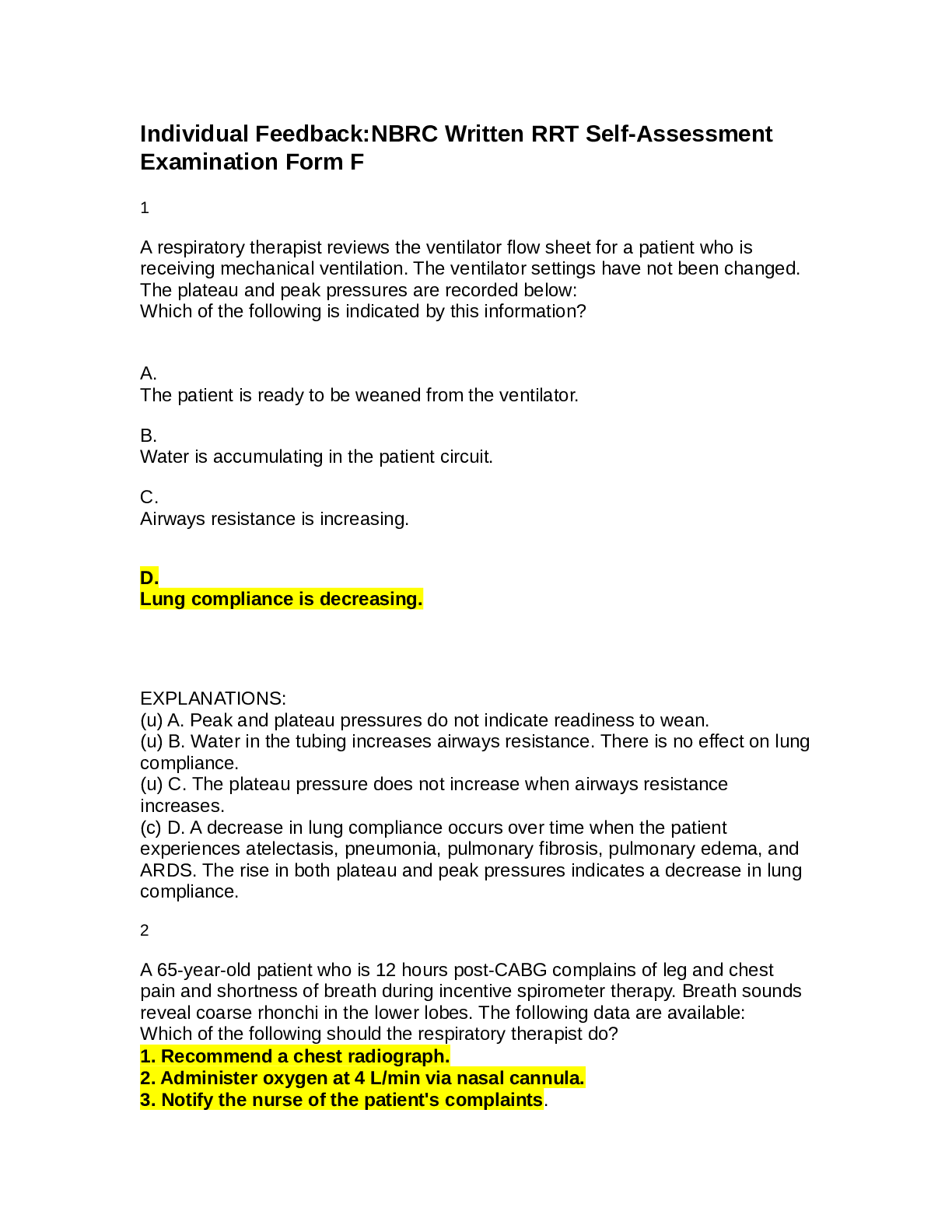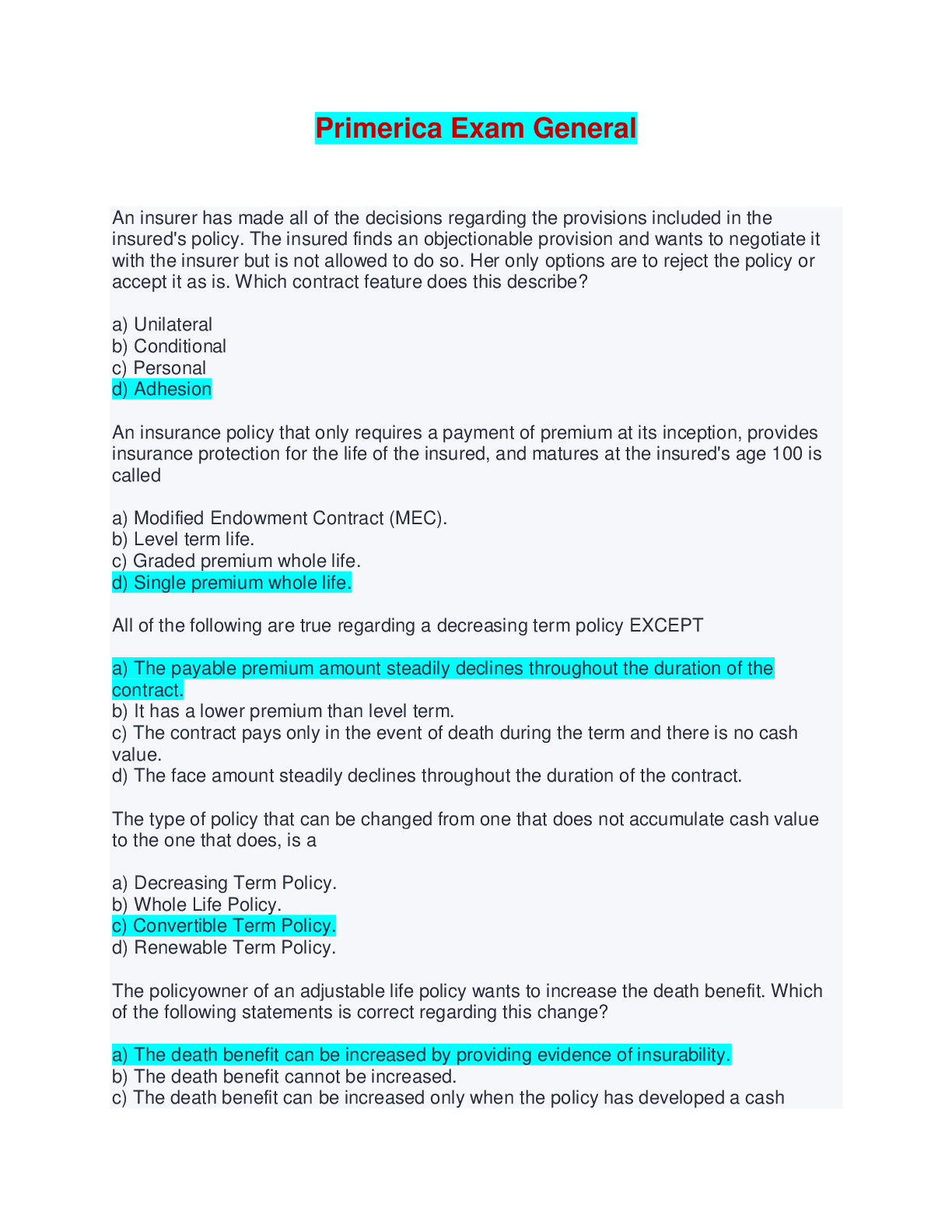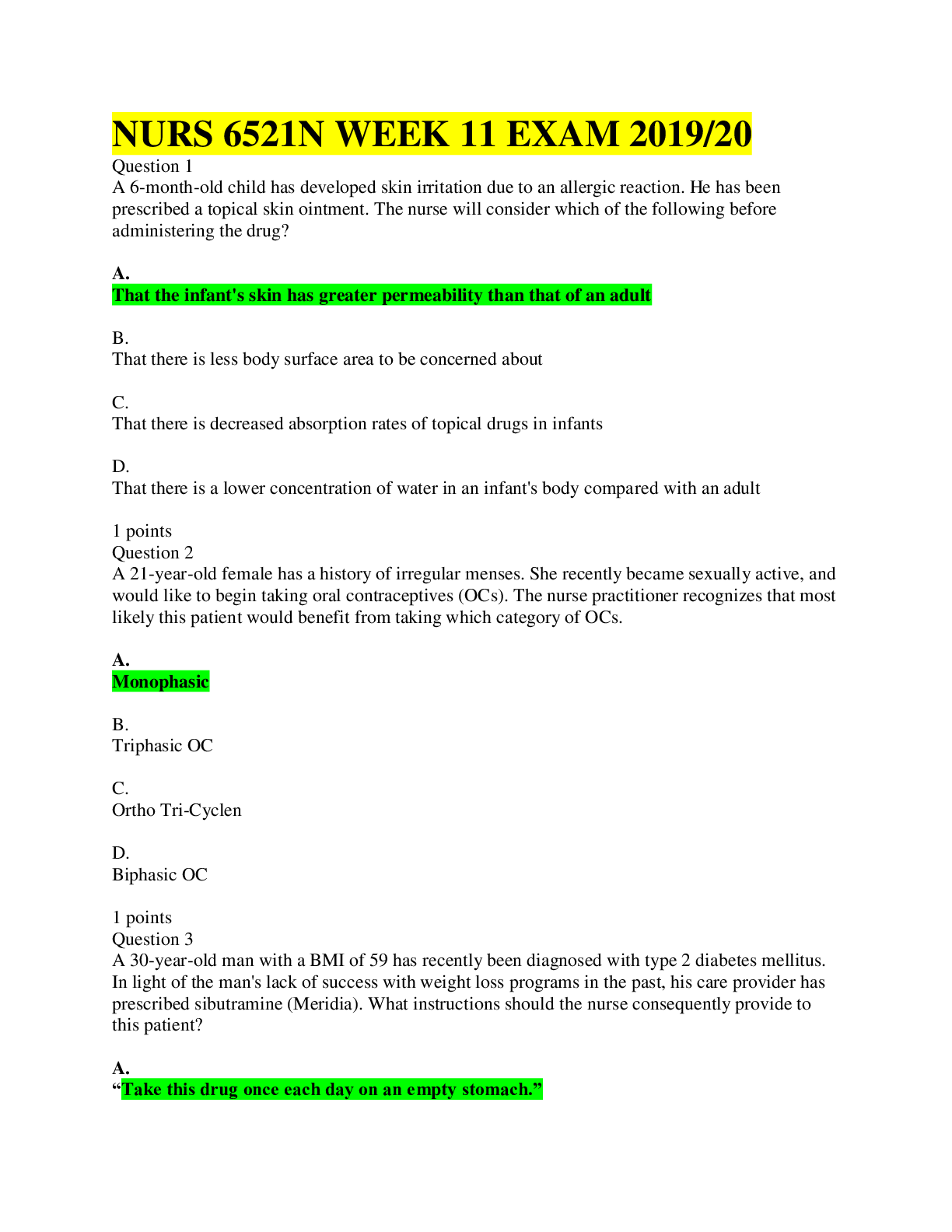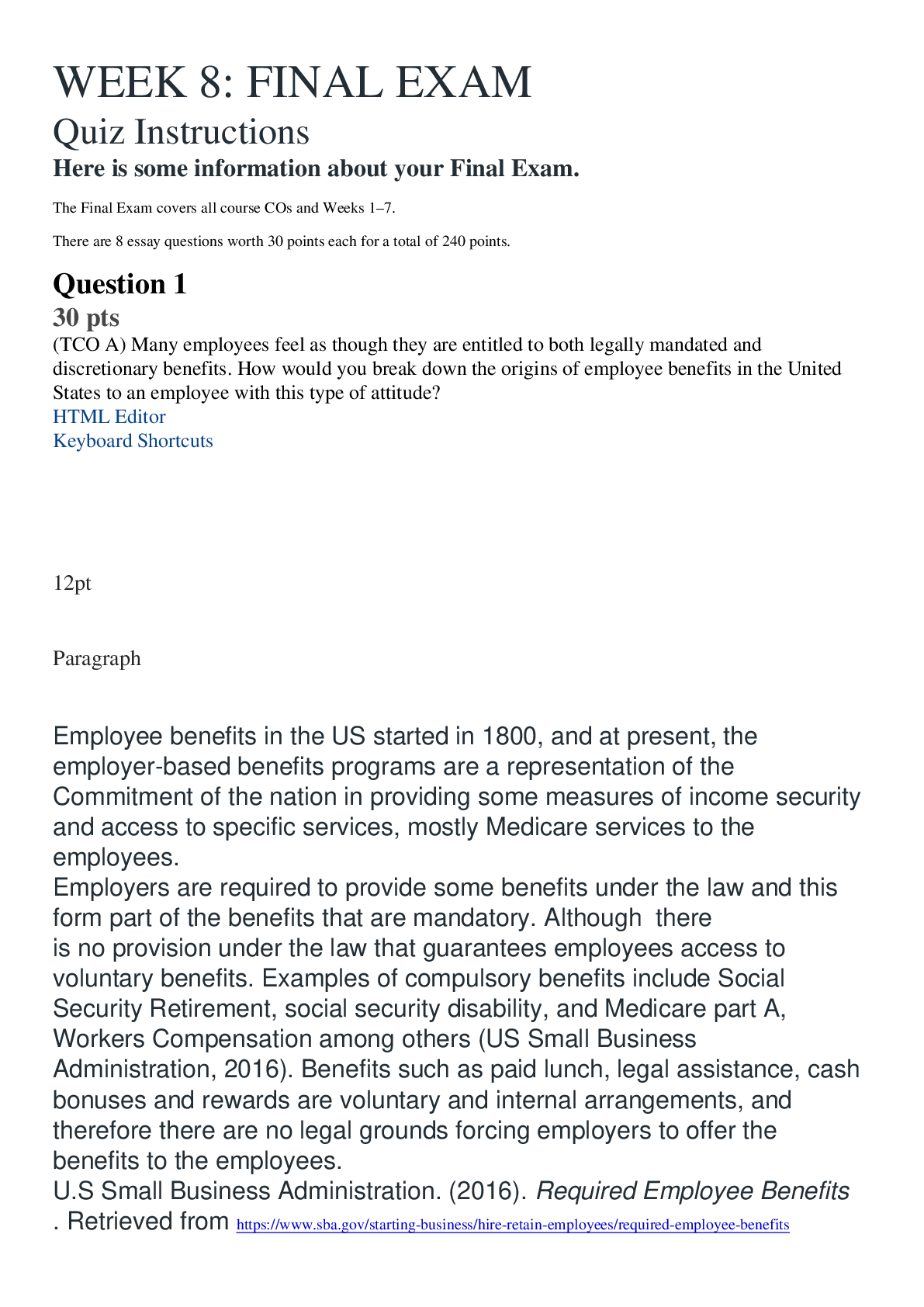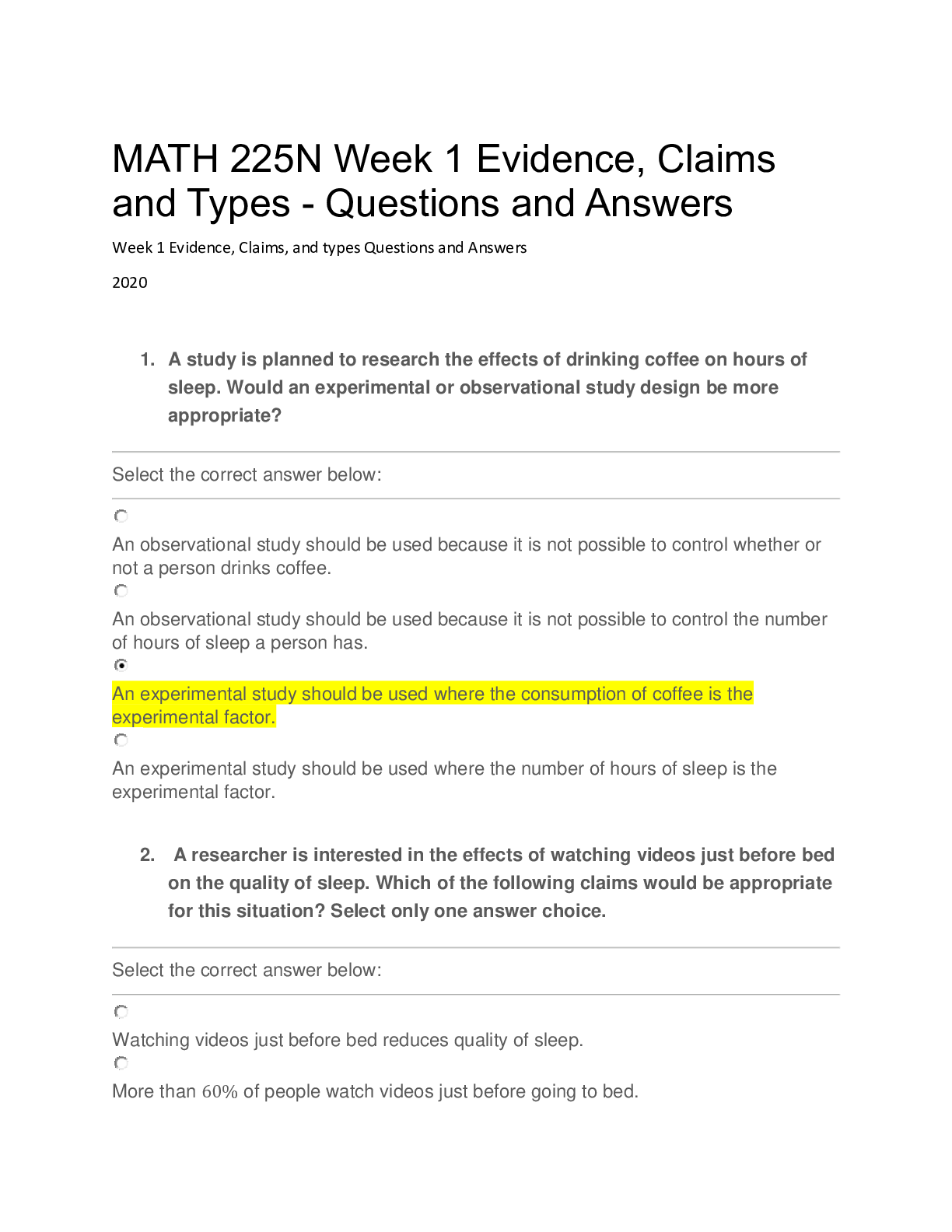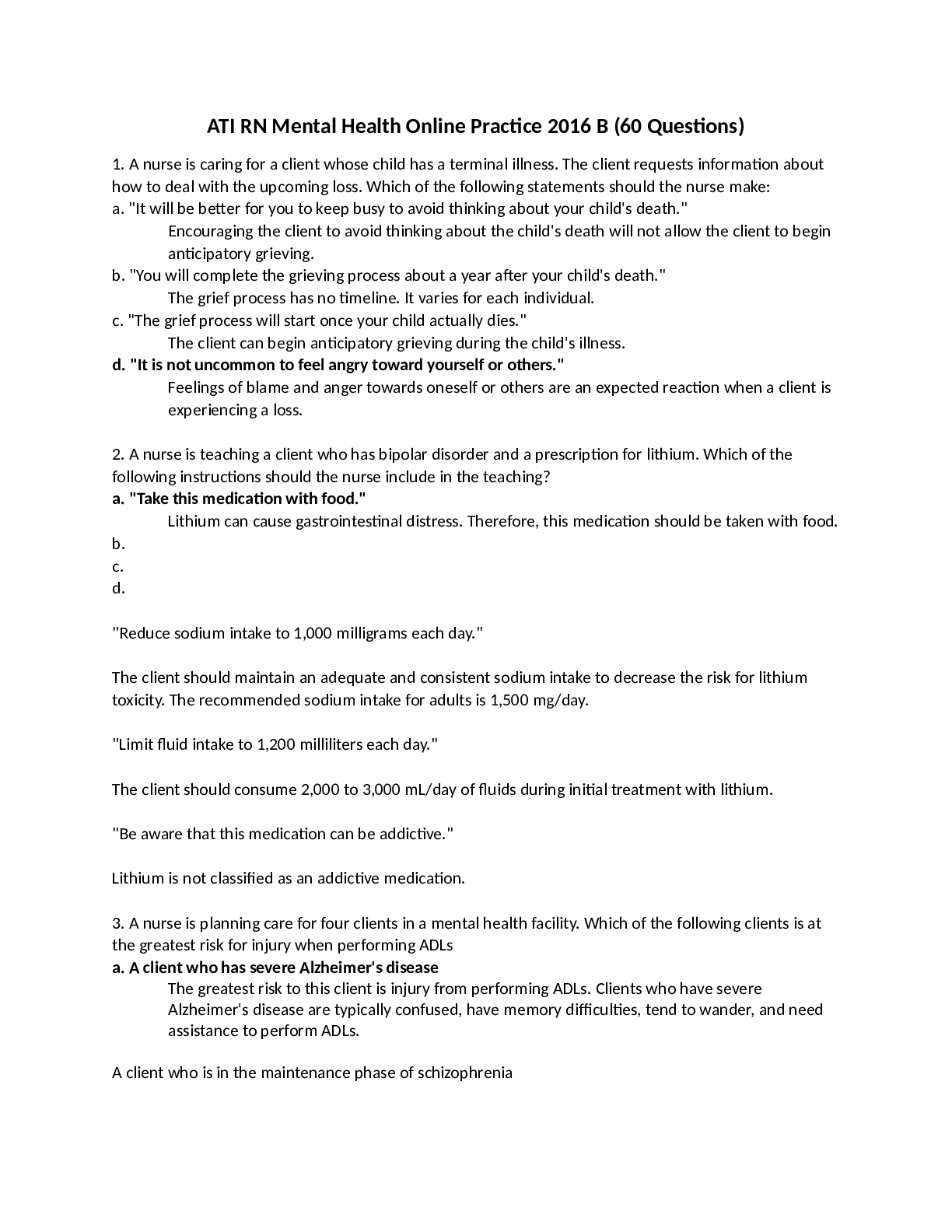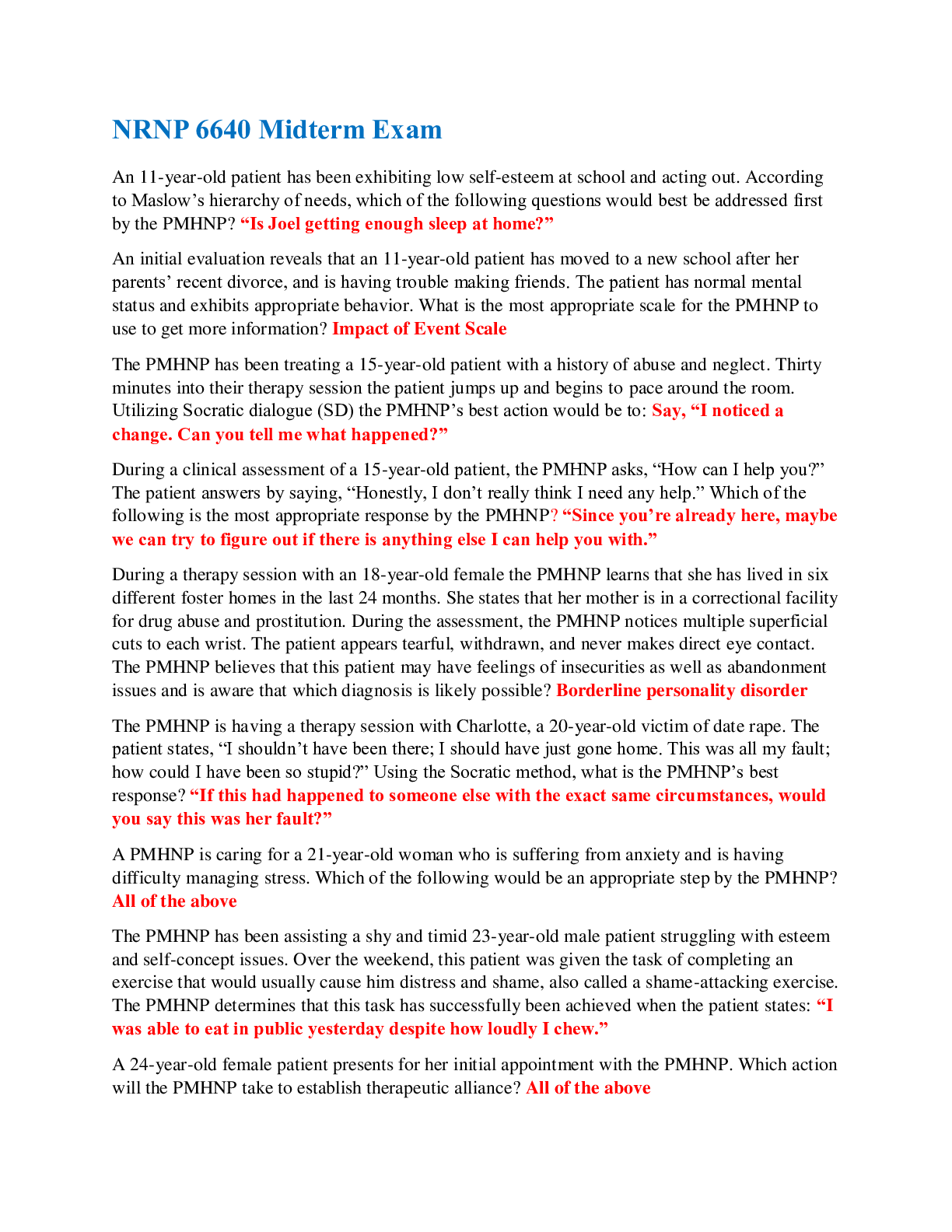Medicine > EXAM > Aquifer Family Med Exam (2024/2025) - Questions and Answers (Complete Solutions) (All)
Aquifer Family Med Exam (2024/2025) - Questions and Answers (Complete Solutions)
Document Content and Description Below
Aquifer Family Med Exam (2024/2025) - Questions and Answers (Complete Solutions) Which of the following is correct regarding breast self-examination? A. Breast self-examination increases the number ... of biopsies performed. B. It is recommended that clinicians teach breast self-examination during annual visits. C. Most cisgender women should regularly perform breast self-examination. D. The practice of regular breast self-examination reduces mortality. What do you think are the risk factors for developing cervical cancer? A. Cigarette smoking B. Early onset of sexual intercourse C. Immunosuppression from HIV or other diseases D. Multiple sexual partners What are the risk factors for developing breast cancer in the general population? Select all that apply. A. Age B. Excessive alcohol intake C. Family history of breast cancer in first-degree relative D. Genetic factors E. Postmenopausal obesity F. Prolonged exposure to estrogen Which of the following are risk factors for osteoporosis? A. BMI > 30 B. Early menopause C. History of previous fracture as an adult D. Sedentary lifestyle E. Smoking Higher BMI (A) seems to be protective by increasing estrogen levels. A 34-year-old cisgender female who has no past medical problems and is not currently taking any medications comes into your office because she noticed a tender lump in her left breast starting approximately one month ago. She is worried because she has a maternal aunt who had breast cancer that was BRCA positive, though her mother is BRCA negative. Her periods have been regular since they started at the age of 13 and occur every 32 days. She is currently menstruating. She has three children, aged 12, 9, and 4. On exam, her BMI is 32, up from 28 three years ago, and her other vital signs are stable. On breast exam, you note a mobile rubbery mass approximately 1 x 1cm that has regular borders and is tender to palpation. You appreciate no axillary adenopathy. The rest of her physical exam is unremarkable. Of the information provided, which of the following puts this patient at increased risk for breast cancer? A. Age B. Age of menarche C. Family history of cancer D. Parity history E. Weight A 64-year-old cisgender female who is overweight with well-controlled hypertension comes to your office with concerns of a lump in her breast that she noticed while showering. She reports having no pain, tenderness, or skin changes. A pertinent review of systems is negative. Menarche began at the age of 10. Her first child was born when she was 31 and she had her second and last child at the age of 33. She experienced menopause at the age of 44. Her mother died of colon cancer when she was 65 and her father passed away from metastatic prostate cancer at the age of 70. She has no history of tobacco use ever and occasionally drinks a glass of wine with dinner. Her BMI is 34. Which of the information provided thus far puts the patient at decreased risk for breast cancer? A. Age B. Age at first birth C. Age at menarche D. Age at menopause E. Weight A 63-year old cisgender female comes into your office for her annual preventive exam. She has hypertension and type 2 diabetes. She is not sexually active. Her blood pressure is 125/80 and her physical exam otherwise is within normal limits. You recommend influenza and zoster vaccination. Her last colonoscopy was eight years ago and her last mammogram one year ago; both were normal. She has never had an abnormal Pap test. At the age of 45 she had a total hysterectomy for fibroids. Of the details provided about this patient, which is an appropriate reason to explain why she does not need a Pap test today? A. She experienced menopause more than 10 years ago B. She had a total hysterectomy for fibroids C. She has never had an abnormal Pap test D. She is 63 years old E. She is not sexually active A 47-year-old cisgender female comes into your office for a health care maintenance exam. She has hypertension and type 2 diabetes. She is not sexually active and has not yet experienced menopause. There is no family history of cancer. Her blood pressure is 118/78, her BMI is 34, and the remainder of her physical exam is within normal limits. Her vaccinations are up to date, and she has a Pap test today and will have labs drawn. According to USPSTF, which of the following is the best recommendation to give her concerning mammography? A. Should have started at age 40 and every year thereafter B. Should have started at age 40 and every two years thereafter C. Should have started at age 45 and every year thereafter D. Start at age 50 and every year thereafter E. Start at age 50 and every two years thereafter A 25-year-old patient presents to the office for follow-up on anxiety and tobacco dependence. She reports she is doing well on her new medication to help with both her mood and smoking, though she continues to smoke. She recently started her first sexual relationship with a new female partner. She received a tetanus vaccine at the age of 18, and she received her flu vaccine this year. Her blood pressure is 122/70, and her physical exam is within normal limits. You review her recent Pap test, which was negative. Which of the following indicates the vaccines she should receive today? Choose the single best answer. A. HPV vaccine alone B. HPV vaccine and pneumococcal conjugate vaccine (PCV13) C. HPV vaccine and pneumococcal polysaccharide vaccine (PPSV23) D. HPV vaccine and Zoster vaccine E. No vaccines are needed The pneumococcal polysaccharide vaccine (PPSV23) is recommended for adults who smoke (like this patient); have chronic heart, lung, or liver illness; have alcohol use disorder; or have diabetes. The pneumococcal conjugate vaccine (PCV13) is not routinely recommended for adults, though it can be given to some patients at the age of 65. The HPV vaccine is recommended for all persons through age 26, with the series starting between ages 9 and 11. A shared-decision making approach is recommended for adults ages 27-45. The Zoster vaccine is not recommended until age 5 A 55-year-old male with no significant past medical history presents for a routine physical exam. He last saw a doctor five years ago. Social history is remarkable for a 35-pack-year tobacco history since the age of 20. He indicates that his wife and children have urged him to quit smoking for the last few months. When you ask him if he has considered quitting, he replies, "I just don't see what the big deal is!" Which stage of change best describes this patient at this time? A. Action B. Contemplation C. Maintenance D. Precontemplation E. Preparation What history related to Mr. Reynolds' risk of cardiovascular disease do you want to obtain? A. Excess alcohol use B. Exercise C. Family history D. History of chest pain with exercise E. History of leg pain with exercise F. Stress G. Tobacco use H. Travel history How effective are oral medications, such as bupropion (Wellbutrin, Zyban, Budeprion) or varenicline (Chantix), in helping smokers quit? A. Moderately effective (Quit rate at 12 months is 3 to 5 times the placebo quit rate.) B. Not effective (Quit rate at 12 months is no higher than placebo quit rate.) C. Somewhat effective (Quit rate at 12 months is 1.5 to 3 times the placebo quit rate.) D. Very effective (Quit rate at 12 months is 5 to 10 times the placebo quit rate.) Which of the following are characteristics of a good screening test? Select all that apply. A. There should be a latent (asymptomatic) stage of the disease. B. There should be a treatment for the condition being screened for. C. The test should be acceptable to the population. D. The test should have low sensitivity and high specificity. E. The total cost of finding a case should be economically balanced in relation to medical expenditure as a whole. Dr. Nayar asks you, "What ECG changes would suggest that Mr. Reynolds has existing coronary artery disease?" Select all that apply. A. Convex ST segment elevation B. Q waves C. Short PR interval D. ST segment depression or downsloping ST segment E. U waves Dr. Nayar asks you which of the following you recommend for Mr. Reynolds now assuming a 17.6% CV risk. Select all that apply. A. Abdominal ultrasound of aorta B. Carotid ultrasound C. Coronary Calcium Score (CAC) D. High sensitivity C-reactive protein (HS CRP) E. Low dose aspirin (81 mg daily) F. Moderate-intensity statin A 48-year-old male with a past medical history that includes hypertension, chronic obstructive pulmonary disease (COPD), and hyperlipidemia presents to the clinic as a new patient in October for a general physical exam. History reveals that he has been smoking a pack of cigarettes daily since age 20. He drinks two beers daily. He is intermittently nonadherent with his medications. A review of the state immunization database reveals that the only immunization he has received as an adult was a tetanus diphtheria shot administered 12 years ago. Which of the following vaccine combinations would be most appropriate for this patient? A. Influenza, meningococcal, and zoster B. Influenza, pneumococcal, and Tdap C. Influenza, zoster, and Tdap D. Meningococcal, pneumococcal, and Tdap E. Meningococcal, pneumococcal, and zoster A 55-year-old male comes to the clinic for a visit. He has read about the dangers of being overweight and inquires about which category he fits into. He is 177.8 cm (70 in) and weighs 99.8 kgs (220 lbs), BMI = 31.6. Which of the following categories most accurately describes the patient based on his BMI? A. Ideal B. Morbidly (very severely) obese C. Obese D. Overweight E. Underweight A 55-year-old male with a family history of melanoma presents to the clinic for evaluation of a skin lesion on his back that appeared three months ago. His wife first alerted him to it, hasn't noticed it change and he has not noticed any symptoms associated with it. Physical examination reveals a 7 mm uniformly black macule that is symmetrically round with sharply demarcated borders on his upper back near the right shoulder. Which of the following characteristics would most justify it being biopsied today? A. Borders B. Color C. Diameter D. Location E. Symmetry A 55-year-old male with no significant past medical history and generally healthy behaviors presents to the clinic for a health care maintenance exam. He says, "I'd like to get tested for all types of cancer." He does not have any family history of cancer. Review of systems is negative for any symptoms of prostate cancer, such as urinary frequency, urgency, retention, hematuria, weight loss, or back pain. He is a lifelong non-smoker, and he doesn't drink alcohol or use recreational drugs. Which of the following screening tests is given either a USPSTF A or B recommendation in favor of its routine use for patients such as this one? A. Colon cancer screening B. ECG screening for coronary artery disease C. Lung cancer screening D. Pancreatic cancer screening E. Prostate specific antigen (PSA) testing Which of the following statements are true regarding hyperosmolar hyperglycemic state (HHS)? Select all that apply. A. Dehydration is a common finding. B. Ketones are absent or mildly elevated. C. Metabolic acidosis is the primary disturbance. D. Plasma glucose levels are commonly > 600 mg/dL. E. The mortality rate is extremely low. In the hallway, Dr. Wilson asks, "Since Ms. Sanchez has not been seen for her diabetes for over a year, which of the following tests are appropriate to order?" Select all that apply. A. 24-hour urine protein and glucose B. Fasting lipid profile (total cholesterol, LDL- and HDL-cholesterol and triglycerides) C. Fingerstick blood glucose D. Hemoglobin A1C E. Liver enzyme tests (LFTs) F. Serum B12 levels G. Serum creatinine and calculated GFR H. Spot urine albumin/creatinine ratio I. Thyroid-stimulating hormone (TSH) Ms. Sanchez would be due for a lipid profile (B), hemoglobin A1C (D), Serum B12 level (F) since she is on metformin, serum creatinine and GFR (G), spot urine albumin/creatinine ratio (H), and LFTs (E). Lipid profiles have historically been done fasting, though there is growing evidence that they may be done without this restriction. Which of the following interventions have evidence of improving cardiovascular disease outcomes that matter to patients with diabetes? Select all that apply. A. Adding a high-intensity statin for patients 40—75 yrs old with LDL-c > 70 mg/dL and ≥ 7.5% estimated 10-year ASCVD risk B. Adding a moderate-intensity statin for patients 40—75 yrs old with LDL-c > 70 mg/dl C. Advising all patients to cut back on their smoking D. Controlling glucose as close to normal range as possible (A1C 4 to 6%) E. Lowering blood pressure in patients with blood pressure > 140/90 mmHg F. Screening asymptomatic patients with diabetes for coronary heart disease (CHD) G. Treating patients with dyslipidemia with diet and exercise H. Using aspirin as secondary prevention in patients with diabetes and a history of CVD Advising all patients to cut back on their smoking has not been shown to improve cardiovascular outcomes; rather, patients should be advised not to use tobacco products. A 60-year-old patient presents to the office with increased frequency of urination and fatigue for the past several months. She reports no fever, dysuria, back pain, diarrhea, or abdominal pain. She has noted some weight loss without working on diet or exercise. Her past medical history is significant for hyperlipidemia and hypertension, for which she takes simvastatin and lisinopril. She is a nonsmoker and consumes one to two glasses of wine per week. Her vitals are: Pulse is 70 beats/minute Blood pressure is 130/70 mmHg Body mass index is 30 kg/m2 Physical examination reveals increased pigmentation in her axilla bilaterally. Her labs are as follows: Random plasma blood glucose: 205 mg/dL Creatinine: 0.8 mg/dL TSH: 2.1 U/L. What is the next most appropriate step in establishing a diagnosis of diabetes mellitus in this patient? A. An oral glucose tolerance test B. Fasting blood glucose C. HgbA1C D. The random blood glucose is sufficient E. Urine microalbumin A 42-year-old patient presents for a visit after recently being diagnosed with type 2 diabetes. She has made a plan to work on diet and exercise. Her A1C is found to be 8.0%. What is the best medicine to start at this time? A. Basal insulin B. GLP-1 receptor agonist C. Metformin D. SGLT2 inhibitor E. Sulfonylurea A 72-year-old patient with a 30-year history of type 2 diabetes and hypertension returns to your office for a routine visit. She is taking 20 units of insulin glargine every morning and five units of insulin aspart with meals. She is on atorvastatin 40 mg daily and lisinopril 40 mg daily. She is on no other medications. Her A1C is 6.5% and her BP today is 145/90. She notes blurry vision for the past several months and a few days of dark spots in her vision. She reports no headaches or nausea. What is the most appropriate next step to slow down the progression of diabetic retinopathy? A. Increase her insulin aspart from five units to seven units with meals. B. Increase her insulin glargine to 23 units every morning. C. Perform a fundoscopic examination and make no changes to her regimen today. D. Start her on a baby aspirin. E. Start her on a calcium channel blocker. A 65-year-old patient with type 2 diabetes mellitus and no other chronic health issues presents to the emergency department with altered mental status. The patient experienced no known head trauma. His vitals are: Temperature is 38.1 °C (100.6 °F) Pulse is 102 beats/minute Respiratory rate is 16 breaths/minute Blood pressure is 90/74 mmHg He responds when you say his name, and he appears well-nourished. His mucous membranes appear very dry. A neurological exam reveals no focal deficits. His plasma glucose is found to be 700 mg/dL. Urinalysis reveals no ketone bodies. What is the most likely diagnosis? A. Cardiac arrhythmia B. Cerebrovascular accident C. Diabetic ketoacidosis (DKA) D. Hyperosmolar hyperglycemic state (HHS) E. Thiamine deficiency A 61-year-old patient has recently been diagnosed with type 2 diabetes. Her fasting glucose was 240 mg/dL and her A1C was 8.9%. Her BP has been 148/90 and 146/86 at two separate office visits. Her home BP measurements have been in a similar range. Her creatinine is 0.9 and she has no known heart disease. She currently takes losartan 100 mg daily for a diagnosis of hypertension. Which of the following would be the most appropriate step in managing this patient's blood pressure? A. Make no changes to her medications as her blood pressure is at goal. B. Start amlodipine daily. C. Start furosemide daily. D. Start lisinopril daily. What are the three most common causes of back pain?" Select all that apply. A. Degenerative joint disease B. Disc herniation C. Kidney stones D. Lumbar strain E. Pyelonephritis F. Spinal stenosis While the patient is standing for a back exam, what should be examined? Select all that apply. A. Ask the patient to jump B. Ask the patient to squat C. Ask the patient to walk D. Check flexion of the spine E. Inspect the curvature of the spine F. Palpate the paraspinal muscle What do you want to check as part of the back exam while the patient is supine? Select all that apply. A. Check for abdominal bruit, especially on older adult patients. B. Check for abdominal tenderness only in female patients. C. Perform FABER test only in older adult patients. D. Perform passive straight leg raise on all patients. E. Perform rectal exam on all patients. "Which of the following findings would support the diagnosis of disc herniation?" Select all that apply. A. Drop foot B. Pain worse with cough and sneezing C. Pain worse with sitting D. Pain worse with standing E. Urinary retention Urinary retention (E) is a symptom consistent with cauda equina syndrome. Standing typically relieves the symptoms of disc herniation (D), so it is incorrect here. What are the red flags or alarm symptoms that would suggest a more serious underlying condition causing his back pain? Select all that apply. A. Fever B. Loss of bowel/bladder control C. Numbness of the leg D. Severe pain that awakens the patient from sleep. E. The worst pain the patient has ever had F. Weight loss While the worst pain a patient has ever had is concerning and needs to be addressed, it is not by itself indicative of a more serious condition. Numbness can be part of cauda equina, but is also common with a simple disc herniation, therefore by itself it is not a red flag. "Now that you have a diagnosis of disc herniation with radiculopathy for Mr. Payne, let's discuss what would you like to do for him." Which of the following are indicated at this time? Select all that apply. A. Moist heat B. Order an MRI C. Prescribe NSAID D. Referral to a back surgeon E. Referral to physical therapy F. Strict bed rest Mr. Payne has no red flags and has had pain for only two weeks, so conservative therapy is appropriate for him. Mr. Payne asks Dr. Lee: "What's the likelihood that this back pain will go away completely?" Select all that apply. A. It is more common for patients with psychosocial distress to recover. B. Longer time to recovery is associated with older patients. C. Most back pain is improved in 4 to 6 weeks. D. Recurrence rate for back pain varies from 35% to 75%. What are the treatment options for radiculopathy of the S1 nerve root due to a large herniated disc at L5-S1? Select all that apply. A. Acupuncture B. Epidural injection C. It has only been five weeks, continue with current treatment D. Osteopathic manipulation E. Surgery A 42-year-old male accountant with a significant past medical history of obesity presents to his primary care physician after one week of lower back pain. After moving into a new home three days ago, he woke up the next morning with bilateral lower back pain without any radiation. He reports no recent trauma, fever, chills, numbness, tingling, or incontinence. He has not had any urinary frequency or dysuria. He takes no medications and has no significant past medical history. Which additional findings in his history or physical exam would make the diagnosis of lumbosacral sprain/strain more likely? A. Abnormal gait B. Increased pain with coughing C. Loss of ankle jerk D. Point tenderness on spinous processes E. Spasm of paraspinal muscles A 37-year-old male who drives a delivery truck presents to your clinic after acute onset of severe lower back pain that began after lifting a large package while at work. When you enter the room, you find him standing, unable to sit comfortably. On physical exam, he has limited lumbar flexion, reduced to 45 degrees, positive straight leg test at 45 degrees on the left, normal gait, but difficulty with heel walk. He has 4/5 strength on the left with ankle plantar flexion. Strength is preserved on the right. Which additional physical exam finding would be consistent with this man's level of disc herniation? A. 2/5 strength on hip flexion B. Decreased range of motion on lumbar extension C. Decreased rectal tone D. Hypoactive ankle tendon reflex E. Positive Stoop test A 78-year-old male with a significant past medical history of chronic kidney disease stage II, coronary artery disease, and hypertension presents with lumbar back pain. He has also been feeling general malaise and chills over the past few days. On review of systems, he reports having some difficulty urinating with hesitancy and pain on urination. Currently, his chronic conditions are well managed with metoprolol, lisinopril, and aspirin. He has never smoked. Vital signs: temperature is 38 °C (100.4 °F), blood pressure is 135/75 mmHg, pulse is 76 beats/minute, and respiratory rate is 15 breaths/minute. Given this history, which of the following physical exam maneuvers would be the most helpful in making the diagnosis? A. Abdominal palpation B. Auscultation for an abdominal bruit C. Digital rectal exam D. Pinprick sensation of the legs E. Straight leg test Working at your clinic, you receive a call from a patient of yours, a 45-year-old male who was seen three days ago complaining of lower back pain. At that time he had no history of trauma, pain that improved while lying down, and no neurologic deficits. He works as a truck driver. He was treated conservatively along with pharmacologic intervention with NSAIDs and muscle relaxants. He calls your office now due to only minimal improvement. And although his symptoms have not changed, he is frustrated with the slow progress, needs to get back to work as soon as possible, and is concerned this might be "something serious." Which of the following is the most appropriate next step in management? A. Ask him to double the dosage of his muscle relaxants B. Obtain a plain film x-ray C. Order an MRI D. Reassure him and schedule a follow-up appointment in a few days E. Schedule him for an appointment immediately A 38-year-old female with a past medical history of sarcoidosis and recent completion of a six-month steroid taper presents to her primary care physician after two weeks of lower lumbar back pain. She does not recall any trauma but began to feel a sharp pain after bending over to pick up laundry. The pain radiates bilaterally into her anterior abdomen. She has found no relief with over-the-counter NSAIDs. On physical exam, she has point tenderness along her vertebrae in the L1-L2 region. There are no neurologic deficits and reflexes are intact. Which of the following is the most appropriate next step in management? A. Order a plain x-ray B. Order complete blood count (CBC) C. Reassess in four weeks D. Recommend conservative management E. Refer to spine specialist Dr. Medel asks you, "Which of the following accurately describes the best way to measure blood pressure?" Select all that apply. A. An adult-sized cuff should be used for most adults. B. The length of the bladder of the cuff must be at least 80% of the arm circumference. C. The patient should be seated quietly for 30 minutes before a blood pressure measurement is taken. D. The patient should be seated on an examination table when a blood pressure is taken. E. The patient's arm should be supported at heart level. Would you recommend a medication to a patient with stage 2 HTN? If so, which medication? Select all that apply. A. Yes; initiate a beta-blocker B. Yes; initiate a calcium-channel blocker C. Yes; initiate a thiazide diuretic D. Yes; initiate an ACE-Inhibitor E. No antihypertensive medication indicated at this time Dr. Medel asks you, "If we are to follow the 2017 ACC/AHA hypertension guidelines, what is the goal blood pressure we want to achieve with this patient?" Choose the single best answer. A. < 130/80 mmHg B. < 140/80 mmHg C. < 150/90 mmHg In the ACC/AHA guidelines, for all patients, the goal blood pressure is 130/80 mmHg. Which of the following statements are true about thiazide diuretics? Select all that apply. A. A 50 mg dose of hydrochlorothiazide reduces blood pressure and decreases morbidity and mortality more than a 25 mg dose of hydrochlorothiazide. B. Thiazide diuretics may cause increases in blood sugar levels. C. Thiazide diuretics should be started at 25 mg in older adult patients. D. Thiazide diuretics should be used with caution in patients with a history of gout. E. Thiazides may affect electrolyte levels. F. Thiazides may be taken in the evening. A) Studies have also demonstrated that despite the availability of 50 mg hydrochlorothiazide tablets, doses of hydrochlorothiazide above 25 mg do not decrease blood pressure further or further reduce morbidity and mortality rates. C) Thiazide diuretics should be started at lower doses such as 6.25 mg or 12.5 mg/d in older adult patients because this population may be more sensitive to this drug class and may experience hypotensive episodes or electrolyte abnormalities. Most other adults can start at 25 mg/d. "Which lifestyle modification will decrease blood pressure the most?" Choose the single best answer. A. DASH eating plan B. Dietary potassium C. Dietary sodium reduction D. Moderation of alcohol consumption E. Physical activity F. Weight loss of 10 kg or less A 21-year-old G1P0 patient presents to the clinic as a new patient to establish prenatal care. Which statement represents something that would not be expected to be a benefit of group prenatal care for this patient? A. Decreases the likelihood of preterm delivery B. Increases adherence to techniques for pain management during labor C. Increases physician contact D. Increases support network E. Shared education between patients A 32-year-old patient at 34 weeks and 5 days gestation (G2P1) presents to the clinic with headache and RUQ abdominal pain. Blood pressure is 172/121 mmHg on examination while seated. No visual changes noted. Edema is present in the hands, bilaterally. Urine dipstick demonstrated 4+ protein. FHT are 117. Which of the following is the most appropriate next step in the management of this patient? A. Daily aspirin B. Expedited delivery of the premature fetus C. Lisinopril D. Strict bed rest until 37 weeks E. Twice-weekly non-stress testing Expedited delivery of the fetus is the best treatment for preeclampsia with severe features. (Note: preeclampsia with severe features is not necessarily an indication for a C-section, however.) A 28-year-old, G2P1 patient delivers a 6 lb., 7oz. baby boy at 39 weeks gestation. At one minute, the baby has blue extremities and a pink body; his arms and legs are flexed and he is moving them vigorously with prompt response to stimulation; HR is 118 bpm and he is coughing and crying vigorously as well. What would his APGAR score be at one minute? A. 6 B. 7 C. 8 D. 9 E. 10 A 21-year-old G1P0 patient presents to the clinic as a new patient to establish prenatal care. Which statement represents something that would not be expected to be a benefit of group prenatal care for this patient? A. Decreases the likelihood of preterm delivery B. Increases adherence to techniques for pain management during labor C. Increases physician contact D. Increases support network E. Shared education between patients [Show More]
Last updated: 1 week ago
Preview 5 out of 67 pages

Loading document previews ...
Buy this document to get the full access instantly
Instant Download Access after purchase
Add to cartInstant download
We Accept:

Reviews( 0 )
$24.00
Document information
Connected school, study & course
About the document
Uploaded On
Jun 21, 2024
Number of pages
67
Written in
Additional information
This document has been written for:
Uploaded
Jun 21, 2024
Downloads
0
Views
11



